Introduction
White balsamic dressing is a game-changer for anyone who loves fresh, vibrant, and light salad dressings. With its delicate, slightly sweet flavor and beautiful golden color, this dressing elevates even the simplest greens. Unlike dark balsamic vinegar, white balsamic keeps your salads looking fresh while delivering a bright tang that complements vegetables, proteins, and even fruits. In this complete guide, you’ll discover how to make a perfect white balsamic dressing at home, the health benefits it offers, and creative ways to use it beyond salads. Whether you’re a seasoned home cook or just starting to build your salad dressing repertoire, this is a recipe you’ll come back to over and over. Let’s dive in.
What Is White Balsamic Dressing?
White balsamic dressing is a light, flavorful vinaigrette made with white balsamic vinegar, a variation of traditional balsamic vinegar. Unlike its dark, syrupy cousin, white balsamic vinegar is aged in stainless steel rather than wooden barrels, preserving its pale color and milder flavor. This characteristic makes it perfect for dressings where you want the bright acidity and slight sweetness of balsamic but without the dark hue that can overwhelm lighter salads or vegetable dishes..Balsamic Vinaigrette Recipe
A typical white balsamic dressing blends this fragrant vinegar with olive oil, mustard, seasonings, and sometimes a touch of honey or maple syrup to balance the acidity. The result is a silky, bright, tangy-sweet dressing that pairs beautifully with fresh greens, tomatoes, cucumbers, and even fruit-forward salads.
White balsamic dressing stands out for its subtle taste profile. It is less sharp than red wine vinegar dressings and more floral than apple cider vinegar dressings, giving it a refined flavor. Whether you drizzle it on a simple green salad or use it to marinate chicken or fish, this dressing is a pantry superstar that brings lightness and elegance to your cooking.
White Balsamic vs. Regular Balsamic
While both vinegars come from grape must, their production processes differ significantly. Traditional balsamic vinegar is aged in wooden barrels for years, developing a dark, rich, caramel-like flavor. In contrast, white balsamic vinegar is pressure-cooked and aged in stainless steel tanks, which preserves a golden color and a milder, less syrupy taste.
The flavor difference is profound. Traditional balsamic has bold, sometimes even smoky undertones, while white balsamic keeps things crisp and floral, making it far more versatile in dressings where you want to preserve the natural colors of your salad ingredients. For example, you wouldn’t want to dress a bright summer strawberry and spinach salad with a dark balsamic that could muddy the vibrant colors — white balsamic keeps everything looking fresh and inviting..Tiger Sauce Recipe
Why Choose White Balsamic?
So why choose white balsamic vinegar? Here are the main reasons:
- Appearance: It won’t discolor your salad ingredients.
- Flavor: A gentle, sweet tang complements both savory and sweet dishes.
- Versatility: Use it on everything from greens to grilled vegetables, roasted chicken, or even pasta salads.
- Nutrition: White balsamic is naturally low in calories and fat-free, while still offering antioxidant benefits (see this balsamic vinegar health benefits article for more details).
White balsamic dressing, therefore, offers all the perks of traditional balsamic vinegar — with a lighter, brighter twist. It’s an ideal choice for those who appreciate freshness, subtlety, and a modern, gourmet flavor profile in their cooking.
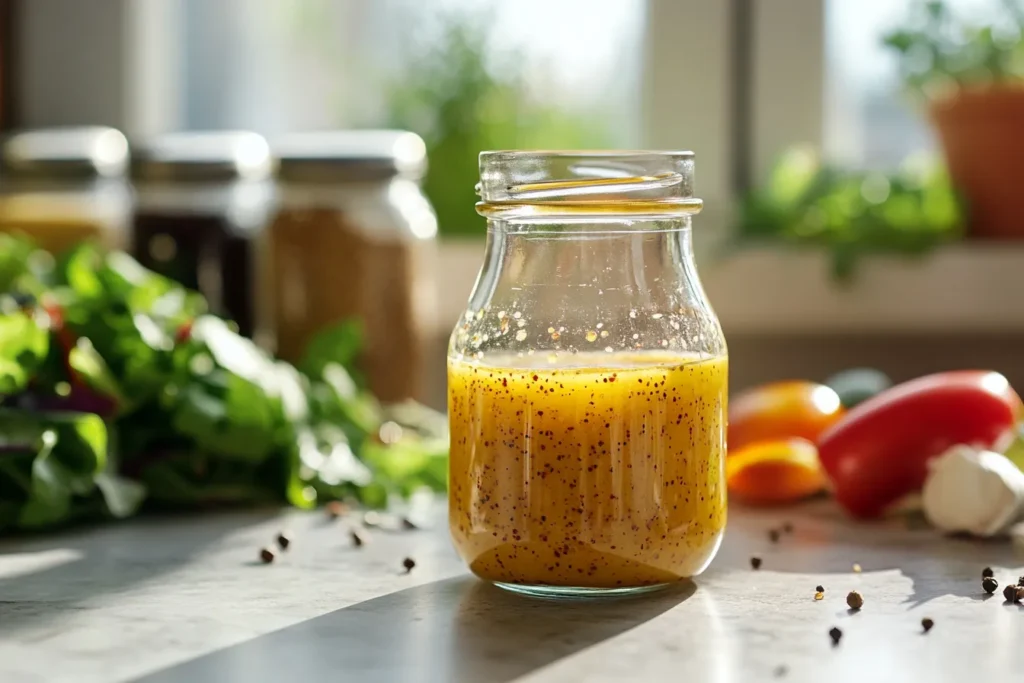
Ingredients for White Balsamic Dressing
Making white balsamic dressing at home is surprisingly simple, and the beauty of it is that you can use common pantry ingredients. This classic vinaigrette style lets the flavor of white balsamic vinegar shine while balancing acidity with smooth olive oil and subtle spices. Here’s what you’ll need for a basic yet delicious white balsamic dressing recipe..Yakiniku Sauce
Must-Have Pantry Staples
Here are the core ingredients you’ll almost always find in a white balsamic dressing:
✅ White Balsamic Vinegar — the star of the show. Look for a good-quality bottle; its floral, slightly sweet acidity forms the base of the dressing.
✅ Extra Virgin Olive Oil — choose a high-quality oil for best results. Olive oil brings richness and helps create a creamy emulsion with the vinegar.
✅ Dijon Mustard — a spoonful of Dijon mustard doesn’t just add a peppery tang; it also helps bind the oil and vinegar together for a stable, silky dressing.
✅ Salt and Pepper — simple, but essential. Sea salt and freshly cracked black pepper elevate all the other flavors.
✅ Garlic — fresh minced garlic or garlic powder adds a gentle bite and a savory undertone.
✅ Honey or Maple Syrup (optional) — a teaspoon or two of natural sweetener can balance the tartness of the vinegar and round out the flavor, especially if you prefer a smoother taste.
✅ Water — a splash can help thin the dressing if it is too strong, ensuring it coats your salad evenly.
These basics are all you need for a stellar homemade white balsamic dressing that’s far better than any store-bought bottle.
Optional Flavor Boosters
One of the joys of making white balsamic dressing at home is customizing it. Here are some fantastic add-ins to try:
✅ Fresh Herbs: Basil, thyme, or oregano bring a garden-fresh note.
✅ Shallots: Finely diced shallots add a gentle onion sweetness without overpowering the vinegar.
✅ Lemon Zest: Adds bright citrus layers and a fragrant finish.
✅ Crushed Red Pepper Flakes: For a subtle kick of heat that balances sweet and tangy notes.
✅ Parmesan Cheese: If you want a creamy white balsamic dressing, whisk in a tablespoon of finely grated Parmesan for an Italian-inspired twist.
These optional additions let you get creative with your dressing, adapting the base recipe to match your meal, the seasons, or simply your mood.
Whether you keep it classic or jazz it up with herbs and spices, white balsamic dressing is incredibly flexible. Plus, it only takes a few minutes to prepare, making it perfect for busy weeknights, meal prep, or even impressing guests.
You can find more creative vinaigrette ideas in this helpful guide on vinaigrette basics — a great resource for mixing and matching flavors beyond the standard oil-and-vinegar approach.
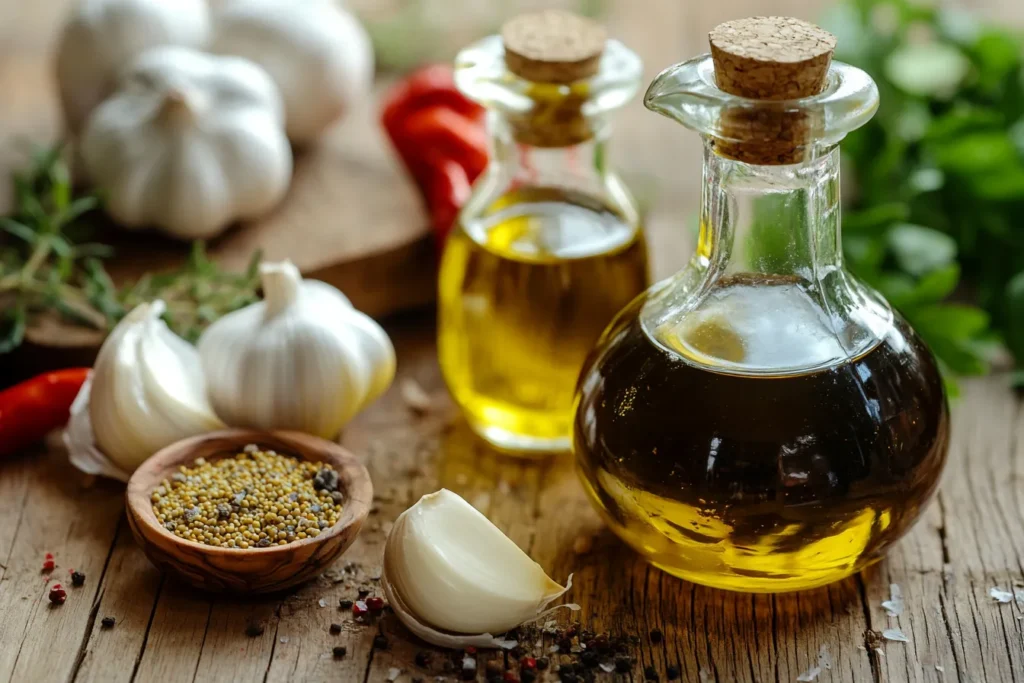
How to Make White Balsamic Dressing
There’s something incredibly satisfying about whisking together your own salad dressing. Not only does homemade white balsamic dressing taste fresher than bottled versions, but it also gives you total control over the ingredients — no preservatives or artificial flavors in sight. Here’s how to make it effortlessly at home.
Step-by-Step Method
✅ Step 1: Gather your ingredients. Measure out the white balsamic vinegar, olive oil, Dijon mustard, garlic, honey (if using), salt, and pepper. Having everything ready before you start helps the process flow smoothly.
✅ Step 2: Combine the vinegar, mustard, and seasonings. In a medium-sized bowl or a mason jar, add the white balsamic vinegar, Dijon mustard, minced garlic, honey or maple syrup, salt, and pepper. Whisk or shake to combine.
✅ Step 3: Slowly add olive oil. While whisking continuously, slowly drizzle in the olive oil. This gradual mixing helps create a stable emulsion, ensuring your dressing stays creamy and doesn’t separate too quickly. If you’re using a jar, just screw the lid on and shake vigorously.
✅ Step 4: Taste and adjust. Dip a piece of lettuce or a spoon into the dressing and taste it. If it’s too tangy, add a bit more olive oil or a splash of water to mellow it out. If it’s too bland, add a pinch more salt or another twist of pepper.
✅ Step 5: Store properly. Transfer any leftover dressing to an airtight container and refrigerate. Give it a good shake before using next time, as homemade dressings can naturally separate over time.
Tips for Perfect Emulsification
✅ Use Dijon mustard — it’s a natural emulsifier that helps oil and vinegar stay mixed.
✅ Whisk steadily — don’t rush the process of combining oil with vinegar. A slow drizzle and steady whisk create a smoother, creamier dressing.
✅ Room temperature ingredients — cold oil and vinegar can make it harder to blend, so let them sit at room temperature for a few minutes before mixing.
✅ Consider a blender — if you want an ultra-smooth and consistent dressing, blend on low speed instead of whisking.
✅ Portion in small batches — if you won’t use a lot of dressing in one sitting, make smaller amounts to keep it tasting its best.
By following these easy steps, you’ll master white balsamic dressing in no time, enjoying a homemade vinaigrette that’s both healthier and tastier than store-bought options.
Homemade white balsamic dressing is endlessly adaptable, so don’t be afraid to experiment with fresh herbs, citrus juice, or even a splash of another vinegar to build layers of flavor. If you’d like more ideas for pairing your dressing with delicious salads, check out this guide on salad pairing ideas.
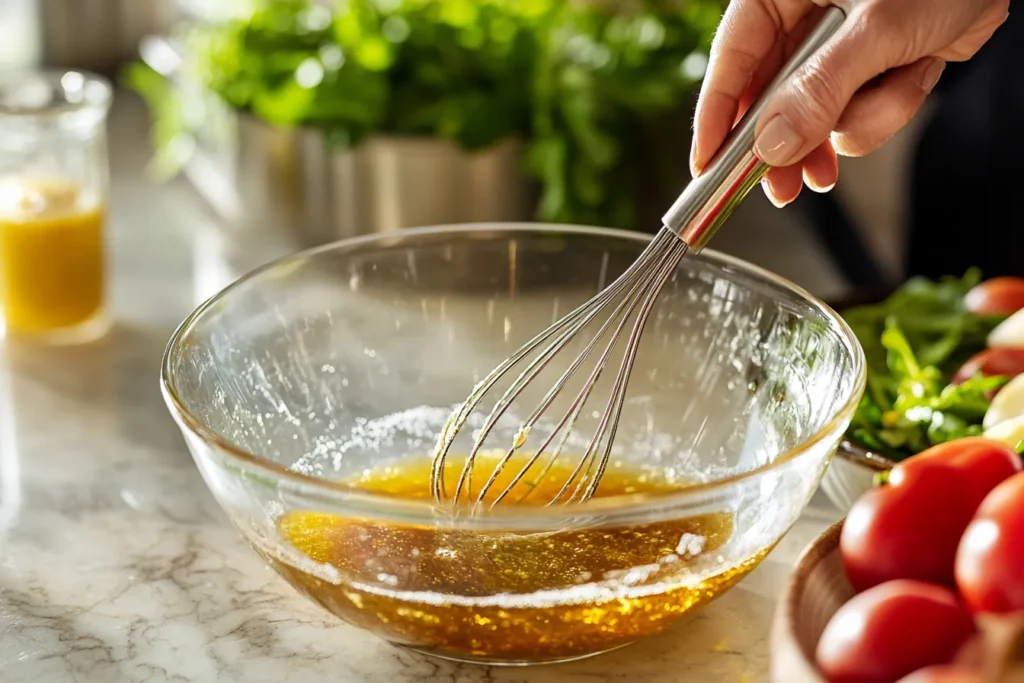
Ways to Use White Balsamic Dressing
One of the best parts about mastering a delicious white balsamic dressing is realizing just how versatile it can be. It’s far more than just a salad topping — you can drizzle, dip, marinate, or even brush it on grilled vegetables. Here’s how to make the most of this bright and tangy dressing.
Classic Salad Pairings
White balsamic dressing’s gentle acidity makes it a star performer on nearly any salad. Here are some classic combinations where it truly shines:
✅ Mixed Greens Salad: Toss your favorite spring mix with cucumbers, cherry tomatoes, and thinly sliced red onions for a fresh, everyday salad.
✅ Spinach and Strawberry Salad: White balsamic dressing complements sweet strawberries beautifully without overpowering their flavor. Top with toasted almonds and goat cheese for extra punch.
✅ Caprese Salad: Fresh mozzarella, basil, and tomatoes get a lovely lift with a drizzle of white balsamic dressing instead of dark balsamic, preserving those bright colors.
✅ Greek-Inspired Salad: Combine crisp romaine lettuce, feta, kalamata olives, and cucumbers. White balsamic dressing delivers a milder twist to the traditional red wine vinaigrette.
✅ Arugula and Pear Salad: Peppery arugula, sliced ripe pears, and a sprinkle of walnuts taste amazing with the slight sweetness of white balsamic dressing.
The possibilities for salad pairings are endless. Because the dressing doesn’t darken your ingredients, it works perfectly on colorful and delicate combinations.
Beyond Salad: Other Dishes
You’d be surprised how many dishes white balsamic dressing can upgrade. Here are some inspired uses:
✅ Marinade for Chicken or Fish: The acidity of white balsamic vinegar helps tenderize proteins, while its sweetness adds a subtle flavor. Use it as a 30-minute marinade before grilling.
✅ Roasted Vegetables: Drizzle it over roasted carrots, asparagus, or Brussels sprouts to add brightness.
✅ Pasta Salads: Instead of mayo-heavy dressings, try tossing cold pasta with white balsamic dressing, chopped veggies, and herbs for a light, fresh flavor.
✅ Sandwich Spread: Whisk a spoonful of white balsamic dressing into mayo or Greek yogurt for a zesty sandwich spread.
✅ Grain Bowls: White balsamic dressing is perfect on quinoa, farro, or brown rice bowls, tying together vegetables and proteins with a fresh kick.
✅ Grilled Fruit: Believe it or not, a drizzle of white balsamic dressing on grilled peaches or pineapple creates a restaurant-quality finish.
This dressing’s versatility really makes it a kitchen essential. Once you master the basic recipe, you’ll find endless ways to make your meals tastier and healthier.
White balsamic dressing doesn’t just add flavor — it brings a sense of freshness and vibrancy to food. And because you control the ingredients, it’s easy to make a clean, wholesome addition to your weekly meal rotation.
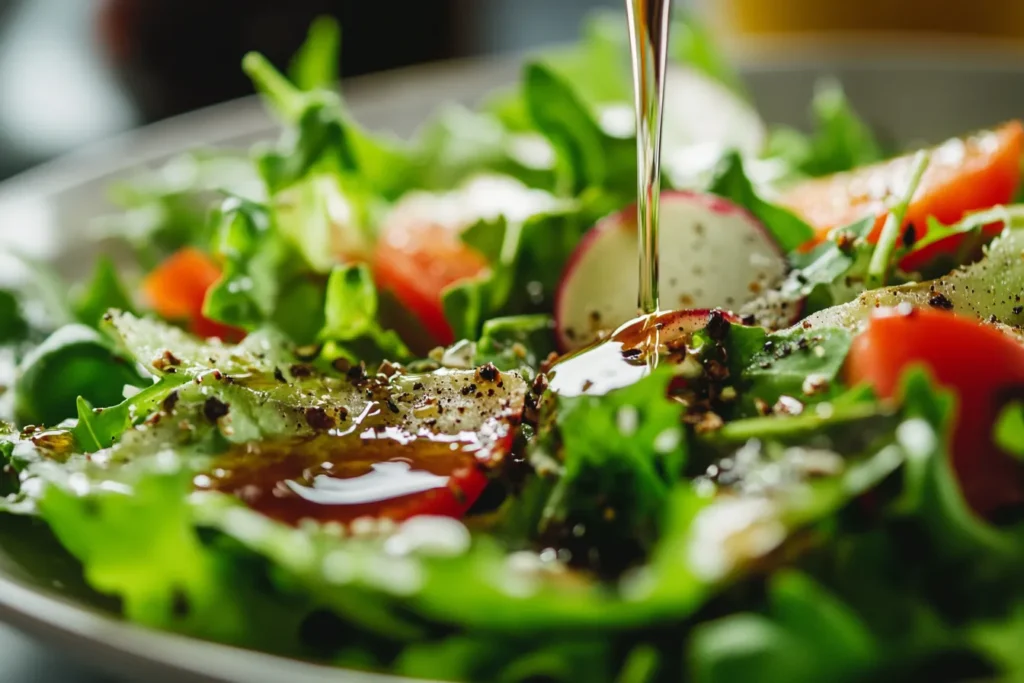
Health Benefits of White Balsamic Dressing
When you make your own white balsamic dressing, you’re not just upgrading your salads — you’re also adding plenty of health benefits to your meals. Let’s break down what makes this dressing a healthy choice.
Nutritional Breakdown
White balsamic dressing is naturally low in calories and contains no saturated fats if made with healthy oils like extra virgin olive oil. The vinegar itself is essentially calorie-free and provides trace amounts of minerals from the grape must. Olive oil contributes healthy monounsaturated fats, which are known to support heart health and help reduce inflammation.
The addition of mustard brings a touch of selenium and magnesium, while garlic adds antibacterial and antioxidant properties. When you use a bit of honey or maple syrup, you get natural sweetness without the refined sugar found in most commercial dressings.
Benefits of Olive Oil and Vinegar
✅ Olive Oil: Rich in antioxidants and oleic acid, which can support healthy cholesterol levels and lower your risk of heart disease.
✅ White Balsamic Vinegar: Contains polyphenols, compounds with strong antioxidant activity that may help reduce oxidative stress. The mild acidity can also aid in digestion and stabilize blood sugar after meals.
✅ No Artificial Ingredients: By making it yourself, you skip the preservatives, emulsifiers, and flavorings found in bottled versions, creating a healthier, more natural dressing every time.
If you’d like to dive deeper into the nutritional side of balsamic vinegars, this balsamic vinegar health benefits article is worth a look.
Common Mistakes to Avoid
Homemade dressings can feel intimidating at first, but with a few simple tips, you’ll avoid the most common pitfalls:
Too Sweet or Too Sour?
Some people go heavy on the honey or vinegar and throw the balance off. Always start with the minimum and adjust in tiny amounts until you hit the perfect harmony.
Separation and Storage
Homemade dressings will naturally separate over time. That’s normal! Just shake or whisk again before serving. Store in a sealed container in the fridge for up to one week.
Frequently Asked Questions
How long does homemade white balsamic dressing last?
About one week in the fridge, stored in a tightly sealed container.
Can I substitute white balsamic for regular balsamic?
Yes, but expect a lighter, milder flavor — and a lighter color.
Is white balsamic dressing vegan?
It is vegan if you skip honey or replace it with maple syrup.
What is the best oil to use?
Extra virgin olive oil gives the best flavor, but avocado oil is a nice alternative.
Can I add honey or maple syrup?
Absolutely — they balance the acidity and soften the flavor beautifully.
Is white balsamic gluten-free?
Yes, pure white balsamic vinegar is naturally gluten-free.
Conclusion
White balsamic dressing is a kitchen hero: fresh, light, versatile, and incredibly easy to make. Whether you pour it over a crisp summer salad, use it as a marinade, or brighten up a grain bowl, it’s a reliable, healthy, and flavorful choice. By choosing simple, clean ingredients, you’ll enjoy a delicious dressing that outshines anything on the supermarket shelf — and with a flavor profile that fits everything from sweet strawberries to hearty roasted vegetables, it’s no wonder this dressing is trending. So grab a whisk, a bottle of white balsamic vinegar, and start transforming your meals today!
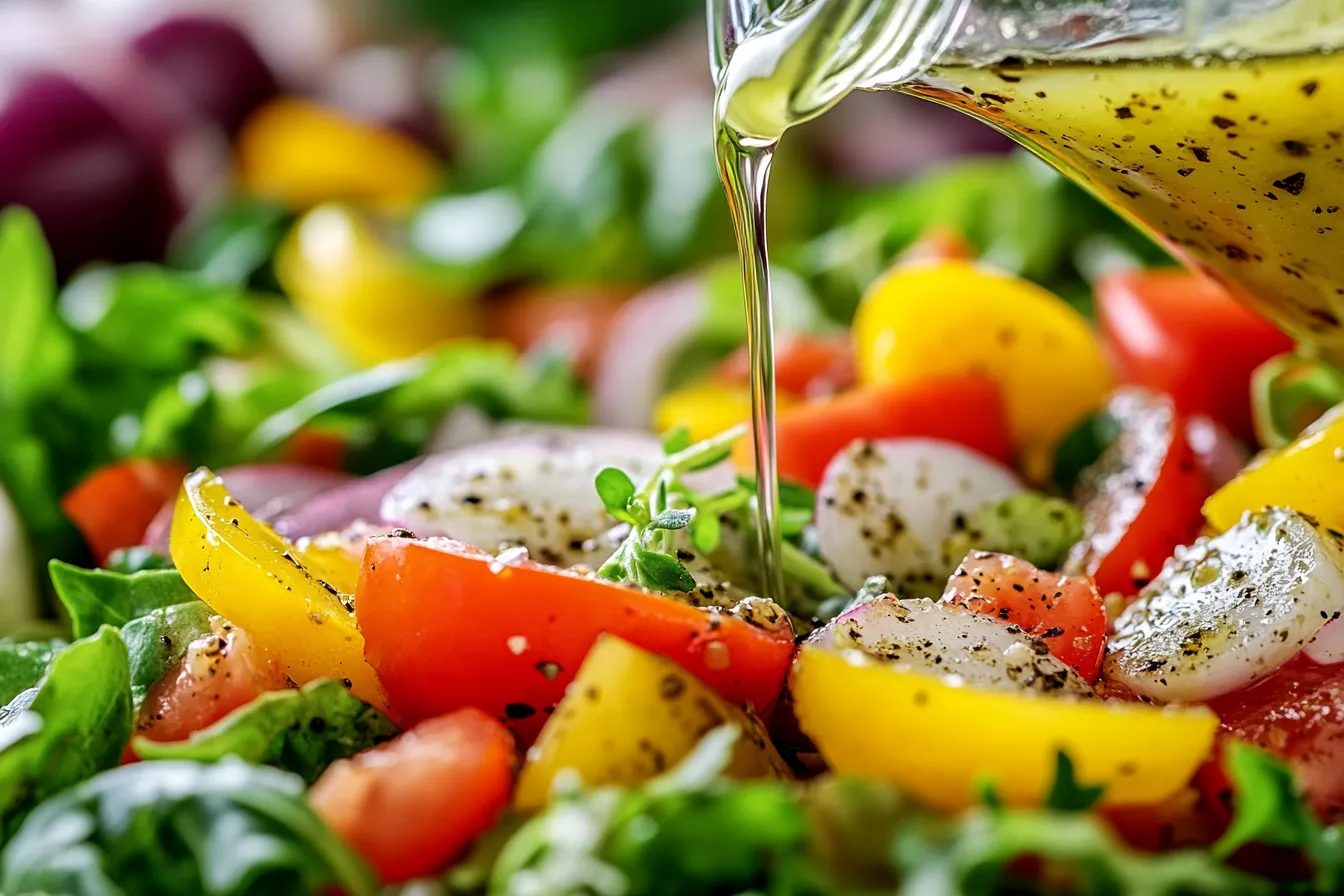
Name: White Balsamic Dressing
Ingredients
Equipment
Method
- ✅ Instructions:
- In a bowl or mason jar, combine the white balsamic vinegar, Dijon mustard, minced garlic, honey (if using), salt, and pepper. Whisk or shake well to combine.
- Slowly drizzle in the olive oil while whisking steadily to emulsify.
- Taste and adjust seasoning, adding a splash of water if it’s too strong.
- Store leftovers in a sealed jar in the fridge for up to one week. Shake before serving.
